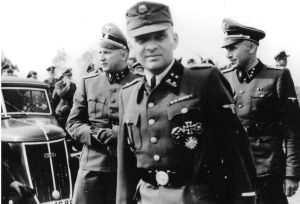Rudolf Höss
Commandant of Auschwitz
Rudolf Hoss at the opening of the SS Lazarett in Auschwitz 1944
Rudolf Höss was born in Baden-Baden on 25 November 1900, the son of pious Catholic parents. His father, a shopkeeper who wanted his son to become a Roman Catholic priest, was a dogmatic, overpowering influence in his early life. After his father’s death, the fifteen-year old Rudolf Höss secretly joined the army, serving on the Turkish front and becoming at seventeen the youngest NCO in the German forces, as well as receiving the Iron Cross (First and Second Classes) for bravery.One year after the defeat of Germany, in 1919 he joined the East Prussian Volunteer Corps for Protection of the Frontier and became a member of the Rossbach Freikorps, taking part in battles in the Baltic region, the Ruhr and Upper Silesia. In 1923 he was involved in a brutal political murder, the so-called Parchim Feme and was sentenced to ten years in prison. One of his accomplices in the murder was Martin Bormann, who subsequently protected Höss at a later stage of his career. Rudolf Höss was released under the Amnesty Law of 14 July 1928, having served less than half his sentence, and for the next six years worked on the land in Brandenburg and Pomerania in various service groups.
In 1934 Rudolf Höss to join the SS and in June of the same year, he was posted to the protective custody camp at Dachau, near Munich, as a block overseer. He was transferred to Sachsenhausen concentration camp in 1938 and promoted to SS- Hauptsturmfuhrer Höss, who stopped over in Wroclaw, to meet with Arpad Wigand, an SS-Oberfuhrer Höss duly submitted his report to Richard Glucks, Höss returned to Auschwitz on 30 April 1940 accompanied by five SS men. On 4 May 1940, he was officially appointed commandant of Auschwitz concentration camp. Höss proved himself the ideal type of passionless ‘desk –murderer’, the quiet bureaucratic, who rarely attended executions, but a man who took great pride in his work, carrying out the ‘will of he Reichsführer- SS’.
Höss to expand the Auschwitz concentration camp to hold 30,000 prisoners, to build a camp at Birkenau for 100,000 Soviet Prisoners of War and to supply prisoners for the construction of an industrial plant in Dwory, for I.G.Farben. On 17 and 18 July 1942 Himmler carried out a second inspection of Auschwitz, which includes witnessing the arrival and selection of a transport of Jews, and witnesses a gassing in Bunker 2, (also known as the ‘White House’) located west of the later site of Crematoriums IV and V. Himmler carried out a thorough inspection of Birkenau and the whole ‘Interest Zone’ and clearly pleased with what Höss had achieved and he was promoted by Himmler to SS- Obersturmbannführer.
Rudolf Höss was replaced as Commandant of Auschwitz by Arthur Liebehenschel on 11 November 1943 and Höss was made head of the No 1 branch of Amstgruppe D of the WVHA, and later he became deputy of Richard Glucks. Höss was not finished with Auschwitz and on 8 May 1944, he returned as commandant to take charge of the forthcoming extermination of the Jews from Hungary. Höss was arrested by British Military police near Flensburg, Schleswig-Holstein, on 2 March 1946 and he was handed over to the Polish authorities just over two months later. Höss was sentenced to death by a Polish military tribunal in Warsaw on 29 March 1947. The execution was carried out on 7 April 1947, next to the house inside the Auschwitz main camp, where he had lived with his wife and five children, and from where he had sent untold numbers of innocent Jewish men, women and children to their deaths.
Sources
R.S. Wistrich, Who’s Who in Nazi Germany, Routledge, London and New York 1995
Danuta Czech, Auschwitz Chronicle, Henry Holt and Company, New York 1989.
G. Reitlinger, The Final Solution, Sphere Books Ltd, London 1971
Auschwitz Nazi Extermination Camp, Interpress Publishers, Warsaw 1985.
Photograph – USHMM
© Holocaust Historical Society -November 20, 2020


